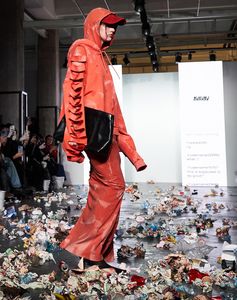The most wonderful thing about the internet is that before things are in fashion, they are a viral trend already. Case in point: The just concluded Milan Fashion Week, where a young Swedish fashion label called Avavav has stolen the spotlight from houses such as Armani, Jil Sander, Missoni, Bottega Veneta, and even Dolce & Gabbana. How did they do it? Cleverly, of course. By making the show less about the collection, and more about virality.
Avavav, under creative director Beate Karlsson, made a great point about fashion ending up in trash cans by having actual trash thrown at the models on the runway. Even as the girls came out for their final walk, show runners from the audience began flinging food waste, plastic bottles and packaged item wrappers at the models. One of the models even tripped and fell, thanks to the amount of waste collected on the runway, leading to a little criticism on the safety of runway models. But also, would you like actual garbage thrown at you even though you were paid for the act? Nope, I don’t think so.
Avavav’s reasoning was personal, its previous collection was called “trash” by online trolls. And it took the hate it received a little too far. I am not sure if this sort of gimmick will take a brand far, more so since this is the venerated Milan Fashion Week, the biggest of all fashion weeks anywhere in the world.
But more importantly, it reminds one of fashion’s often neglected connection with trash. For many, on so many levels, both words are interchangeable. Those in serious and possibly dull professions find fashion frivolous and thus worthy of garbage. Never mind that they will wear only mass fashion off the various high street labels or then cheap chic items sold online. In the words of The Devil Wears Prada’s Miranda Priestly (played by the great, and possibly apologetic fashion queen Meryl Streep), “And then cerulean quickly showed up in the collections of eight different designers. Then it filtered down through the department stores and then trickled on down into some tragic casual corner where you, no doubt, fished it out of some clearance bin”. Incidentally, the Screen Actors Guild awards going on at the same night in Los Angeles, had the film’s stars—Streep, Anne Hathaway and Emily Blunt—reunite to mouth some famous lines from the film.
Fashion’s real connection with trash is of course the mass stores that we all flock to. One stroll into Zara’s newest collection sees everything made of polyester. All polyester is made of plastic. But apart from the fabric that is itchy, sweaty and highly flammable, there is a lot of plastic trash in our clothes in places we can’t see them. Like buttons, zippers, labels, and elastic, wherever the fabric is meant to stretch (waists, necks, wrists and ankles included).
Polyester and nylon account for nearly 70 per cent of materials used in clothing globally. This figure is supposed to increase by another 75 per cent by 2030, according to the environmental consultancy Eco-age. A recent report by a sustainability not-for-profit called Fibershed finds that the production of polyester has increased 900 per cent between 1980 and 2014, in less than 35 years.
Fashion’s dependence on plastic to dress eight billion and counting people is taking its toll. But it is mostly overproduction and overconsumption that is leading to a world that’s unhealthy for us as well as the ecosystem.
Basically, if textile is not organic or handloomed, it is no different than trash. And that’s the lesson a fashion show must teach us.


